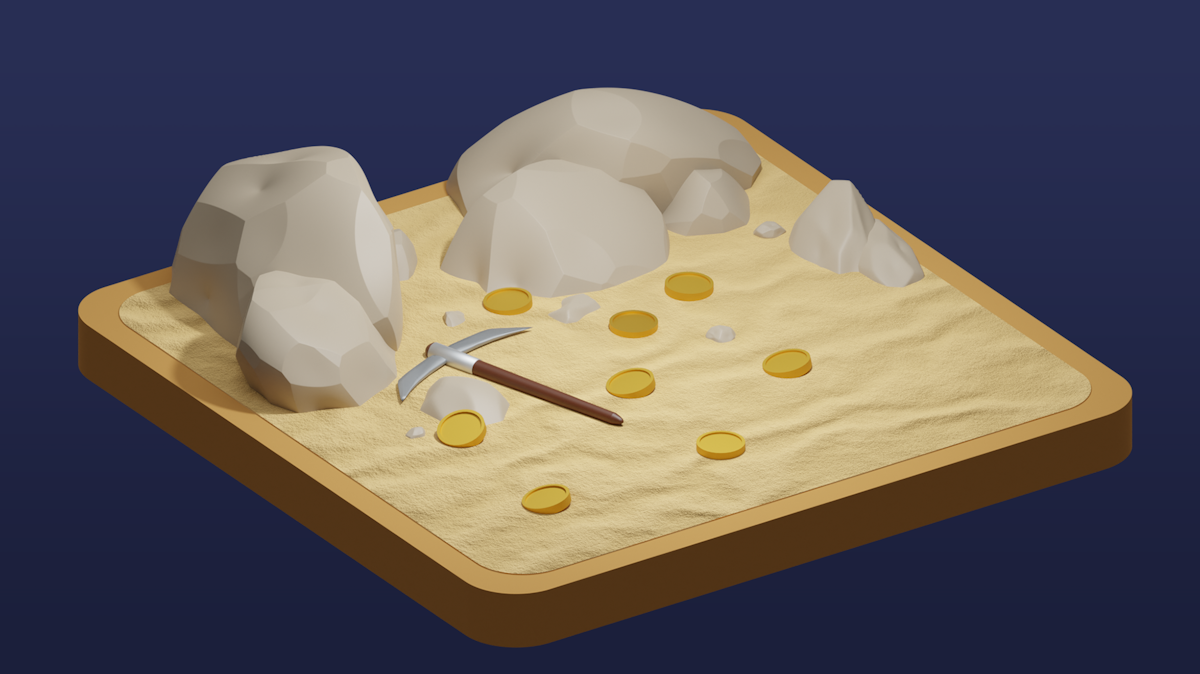What is mining?
Mining a cryptocurrency means getting new coins by providing computing power to a Proof-of-Work blockchain network, solving cryptographic puzzles and validating transactions. Today's lesson is about cryptocurrency mining. Of course you know what Bitcoin miners do, it has been talked about many times in various media. But how does it actually work and what variants are there?
Brief summary
✔️ Mining a cryptocurrency involves obtaining new coins by providing computing power to a blockchain network and solving cryptographic puzzles.
✔️ Blockchains are distributed databases maintained and shared by computers. When new information about transactions is added to the blockchain, it is called a block.
✔️ In Bitcoin, a block is mined every 10 minutes, so that in 2140 the last blocks will be mined. To ensure that mining stays on schedule, Bitcoin halving takes place every 4 years.
✔️ You have different types of crypto mining, for example, you can use rig mining, a mining pool, mini miner, a dedicated miner as well as your phone or PC.
What exactly is mining?
When we talk about mining a cryptocurrency, we mean getting new coins for providing computing power to a blockchain network and solve cryptographic puzzles. Quite a mouthful. Let's highlight the elements of this sentence.
What is a blockchain?
Blockchains are distributed databases. That means computers maintain the database and share it with each other. Occasionally, new information is added from new transactions and coins. These are added to the blockchain. This is called a block.
A blockchain chain with contiguous blocks
This block is added at the end of the chain (chain). Hence the name blockchain. This information must be recorded, otherwise it is impossible to determine how many coins everyone has.
It should be noted that it is all automatic and thus the network does not need a central authority to be updated. With a fancy word, we call blockchain decentralized.
Block reward
Adding a new block may only be done by the computer that has done a particular job. It usually involves a difficult puzzle that all miners try to solve. Whoever solves the puzzle using their computer's computing power adds a block to the chain and receives as a reward newly minted coins and the transaction fees for the various transactions. This process is proof of work called mining, another name for mining.
Bitcoin mining
The best known coin using proof-of-work mining is Bitcoin. Because this coin is worth so much, of course everyone wants to join. Because so many people participate, the creator of Bitcoin has , Satoshi Nakamoto, came up with something very clever: the more people participate, the more difficult the puzzle you have to solve becomes.
Bitcoin mining works so that you then need more and more computer power for mining. The people who can afford a very powerful computer and the energy costs to run it mine virtually all new Bitcoins. The energy required to mine Bitcoins worldwide is about as much as that of a country like Sweden.
If the puzzle did not become more difficult, many more Bitcoins would be mined than the creator intended. That is why this is automatic. If too many Bitcoins are mined, the difficulty goes up, if too few are mined, it goes down.
Bitcoin halving
The idea is that a new block will be mined at Bitcoin about every 10 minutes, so that the last blocks will be mined in 2140. Every four years, the number of new Bitcoin per block is halved. This is called the halving mentioned. This keeps them on track to mine the last of the 21 million Bitcoins by 2140.
After the halving, every time so far, Bitcoin and in its wake other cryptocurrencies have followed a big rise. This is called the bull market. The reason for this is that if Bitcoin remained worth the same amount and you only get half, many miners would drop out because the costs would become higher than the revenues.
What forms of crypto mining are there?
You can also mine other coins, as long as the coin works with proof of work. There are a number of possibilities at crypto mining:
By phone
With your PC
With a mining rig
Through a pool
With a mini miner
With a dedicated miner
Mining with the phone
Mining with your phone is not recommended. It drains your battery and normally does not yield anything. There are coins that work with this, but most of the time they are scams or coins that simply advertise products and you are the conduit for those advertisements through your network. An estimate of the number of coins you can collect per day with your phone for the coin Electroneum, for example, is 5 per day. Negligible considering its price and it is bad for your phone's battery.
PC mining
With your PC Mining is also not recommended. You cannot beat professional equipment with it and power costs are high. Furthermore, a PC is not made for the mining process and the hardware can get very hot and burn out or even catch fire. So don't.
Rig mining
With a mining rig you can mine profitably, although that remains to be seen with high power prices. A mining rig is made specifically for mining. Coolers are everywhere so the heat is contained. Still, it is virtually impossible to get a standalone crypto miner to be profitable. That's because the puzzles are so difficult.
Mining pool
If you go through a pool is going to mine with a mining rig you can most certainly be successful. However, power costs will also count heavily here. In a crypto mining pool, you all provide the computing power to solve a puzzle together. Then, of course, you have a much better chance. You will then also have to share revenue, but at least you will have income. Whether that is enough to cover your costs can be seen on sites that have a calculation formula for mining. Whattomine.com is a good example.
Mini mining
With a mini miner you can mine at low power costs. Usually you can only mine low value crypto, but because the power costs are very low, it is certainly possible to make a profit. Some technical knowledge is necessary, but on Discord there are good groups for this.
Dedicated miners
With a dedicated miner such as a Bitcoin miner you may have the best chance of making money. Nevertheless, power costs will again be the bottleneck here, but dedicated miners tend to be much more effective. If you use a dedicated rig, the returns may still be negative; you'll have to look for that too.
A miner like Helium's is already a lot more effective. It uses very little power and mines based on proof of coverage, that is, you get coins for providing coverage of the Helium network's broadcast signals.
Conclusion
Mining in most cases is best left to professionals. They have the equipment and knowledge to successfully coin new coins and maintain the network in this way.
Proof-of-Work uses a lot of energy. The possibility exists that someday a less energy-guzzling method for it will be invented, but until then, most miners will store their equipment in countries where energy is cheap or easily generated.

